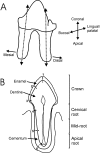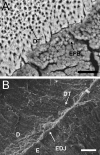Analysis of the surface characteristics and mineralization status of feline teeth using scanning electron microscopy
- PMID: 17062022
- PMCID: PMC2100337
- DOI: 10.1111/j.1469-7580.2006.00643.x
Analysis of the surface characteristics and mineralization status of feline teeth using scanning electron microscopy
Abstract
External resorption of teeth by odontoclasts is a common condition of unknown origin affecting domestic cats. Odontoclastic resorptive lesions involve the enamel cementum junction (ECJ, cervix) and root surface, leading to extensive loss of enamel, dentine and cementum. This study was undertaken in order to determine whether features of the surface anatomy and mineralization of feline teeth could explain why odontoclastic resorptive lesions are so prevalent in this species. Backscattered electron scanning electron microscopy was used to study enamel, cementum and dentine in non-resorbed, undemineralized teeth from adult cats. Analysis of the ECJ revealed thin enamel and cementum and exposed dentine at this site. Furthermore, enamel mineralization decreased from the crown tip to the ECJ, and dentine mineralization was lowest at the ECJ and cervical root. Analysis of cementum revealed variations in the organization and composition of fibres between the cervical, mid- and apical root although no significant differences in mineralization of cementum were detected between different regions of the root. Reparative patches associated with resorption of cementum by odontoclasts and repair by cementoblasts were present on the root surface. In conclusion, results suggest that the ECJ and cervical dentine could be at a greater risk of destruction by odontoclasts compared with other regions of the tooth. The relationship of these features to the development and progression of resorption now requires further examination.
Figures








References
-
- Banerjee A, Boyde A. Autofluorescence and mineral content of carious dentine: scanning optical and backscattered electron microscopic studies. Caries Res. 1998;32:219–226. - PubMed
-
- Berger M, Schawalder P, Stich H, Lussi A. Neck lesions in big cats – examinations in the leopard (Panthera Pardus) Kleintier Praxis. 1995;40:537–549.
-
- Berger M, Schawalder P, Stich H, Lussi A. Feline dental resorptive lesions in captive and wild leopards and lions. J Vet Dent. 1996a;13:13–21.
-
- Berger M, Schawalder P, Stich H, Lussi A. Differential diagnosis of resorptive lesions (FORL) and caries. Schweiz Arch Tierheilkd. 1996b;138:546–551. - PubMed
-
- Bilgin E, Gurgan CA, Arpak MN, Bostanci HS, Guven K. Morphological changes in diseased cementum layers: a scanning electron microscopy study. Calcif Tissue Int. 2004;74:476–485. - PubMed
MeSH terms
LinkOut - more resources
Full Text Sources
Miscellaneous

